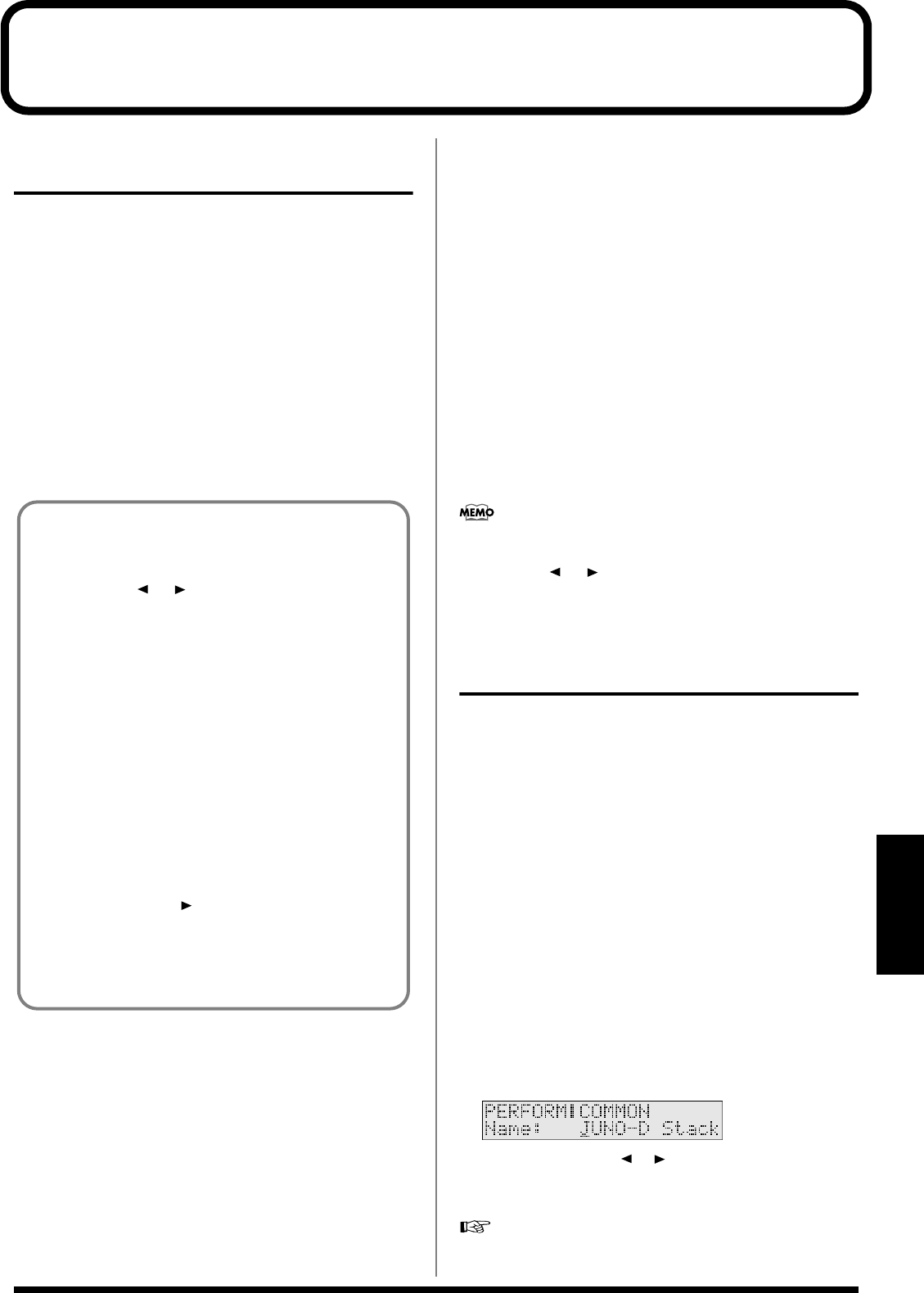
55
Performance Mode
Playing more than one sound simultaneously (Performance mode)
Choosing a part and selecting
the sound
A performance contains sixteen parts that let you play different
sounds simultaneously. Here’s how to switch parts and assign a
patch (or rhythm set) to each part.
1.
Press [PERFORM] so it is lit and you are in Performance
mode.
2.
Press [PART SELECT] so it is lit, and use [0]–[9] to select a
part.
Press [0] to select part 10 (Rhythm). To select the parts 11–16,
hold down [SHIFT] and press [1]–[6] (p. 43).
3.
Use VALUE [-]/[+] to specify a patch or a rhythm set for the
part.
You can also select a patch using the [NUMERIC] function.
Selecting performance numbers
Press [PART SELECT] so it will go out.
Using VALUE [-]/[+]
Pressing VALUE [-]/[+] will select the performance that precedes or
follows the currently selected performance.
You do not need to press [ENTER] after making your selection. The
number you select will take effect immediately, and the performance
will be selected.
Using the direct access buttons
• When not using the [NUMERIC] function
Use the [0]–[9] buttons to input a number.
The upper digit will remain fixed, and only the lower digit will
change. This is a convenient way to step through the numbers in
succession.
You do not need to press [ENTER] after making your selection.
The number you select will take effect immediately, and the
performance will be selected.
• When using the [NUMERIC] function
1.
Press [NUMERIC] so it is lit.
2.
Use the [0]–[9] buttons to input a two-digit number.
The indication will blink.
3.
If you want to finalize the value, press [ENTER].
The value will be finalized, and [NUMERIC] will go out.
If you decide to cancel, press [EXIT].
User performances will be displayed after the end of the preset
performances. You can hold down [SHIFT] and use PAGE/
CURSOR [ ]/[ ] to switch between display of user and
preset performances.
Editing the settings of a
performance
The
performances
of the JUNO-D contain settings that are made for
the entire performance, and settings that are made individually for
each part of the performance.
Settings made for the entire performance are:
• Settings for the entire performance, such as the performance
name (p. 55)
• Effect settings for the performance (p. 56)
Settings made individually for each part of the performance are:
• Performance part settings (p. 56)
• Effect settings for performance parts (p. 58)
Making settings that apply to the
entire performance
1.
Press [PERFORM] so it is lit and you are in Performance
mode.
2.
Select a performance.
3.
Press [PARAM] so it is lit.
fig.r06-50_40
4.
Use PAGE/CURSOR [ ]/[ ] to select a parameter, and
use VALUE [-]/[+] to specify its value.
You can modify the following parameters.
To save the edited performance, refer to
“Saving a
performance”
(p. 59).
Assigning patches of the same category to
multiple parts
While [PART SELECT] is lit, you can hold down [SHIFT] and use
PAGE/CURSOR [ ]/[ ] to step through the categories
assigned to each part, selecting patches of the previous or next
category group regardless of the button that is selected. This lets
you assign patches of other categories than printed on the panel
to each part.
For example, if you want to prepare multiple patches
of the same category, such as two types of organ, you can use the
above method to select organ patches for a category that you do
not use.
Quickly and consecutively auditioning the
built-in sound of the JUNO-D /
Viewing a list of just the user patches
Using the above procedure, you can listen consecutively to all
the built-in sounds of the JUNO-D without pressing a category
select button. Among the user patches organized into category
groups, you can also view a list of just the user patches. Hold
down [SHIFT] and press [ ] to switch categories, and after the
“Bass” category you will see the user patches (u001–u128)
displayed as a category.
* Only when viewing a list, the “u” at the beginning of user patch
numbers will be displayed as a lowercase character.
JUNO-D_e.book 55 ページ 2004年6月11日 金曜日 午後1時21分


















